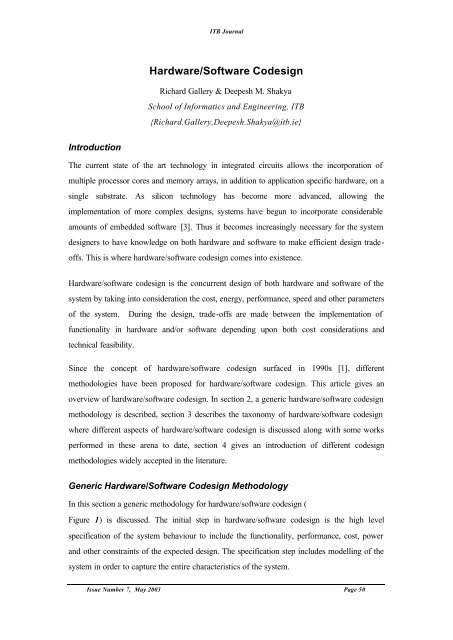ITB Journal-May-2003 - Institute of Technology Blanchardstown
ITB Journal-May-2003 - Institute of Technology Blanchardstown
ITB Journal-May-2003 - Institute of Technology Blanchardstown
You also want an ePaper? Increase the reach of your titles
YUMPU automatically turns print PDFs into web optimized ePapers that Google loves.
<strong>ITB</strong> <strong>Journal</strong><br />
Hardware/S<strong>of</strong>tware Codesign<br />
Richard Gallery & Deepesh M. Shakya<br />
School <strong>of</strong> Informatics and Engineering, <strong>ITB</strong><br />
{Richard.Gallery,Deepesh.Shakya@itb.ie}<br />
Introduction<br />
The current state <strong>of</strong> the art technology in integrated circuits allows the incorporation <strong>of</strong><br />
multiple processor cores and memory arrays, in addition to application specific hardware, on a<br />
single substrate. As silicon technology has become more advanced, allowing the<br />
implementation <strong>of</strong> more complex designs, systems have begun to incorporate considerable<br />
amounts <strong>of</strong> embedded s<strong>of</strong>tware [3]. Thus it becomes increasingly necessary for the system<br />
designers to have knowledge on both hardware and s<strong>of</strong>tware to make efficient design trade<strong>of</strong>fs.<br />
This is where hardware/s<strong>of</strong>tware codesign comes into existence.<br />
Hardware/s<strong>of</strong>tware codesign is the concurrent design <strong>of</strong> both hardware and s<strong>of</strong>tware <strong>of</strong> the<br />
system by taking into consideration the cost, energy, performance, speed and other parameters<br />
<strong>of</strong> the system. During the design, trade-<strong>of</strong>fs are made between the implementation <strong>of</strong><br />
functionality in hardware and/or s<strong>of</strong>tware depending upon both cost considerations and<br />
technical feasibility.<br />
Since the concept <strong>of</strong> hardware/s<strong>of</strong>tware codesign surfaced in 1990s [1], different<br />
methodologies have been proposed for hardware/s<strong>of</strong>tware codesign. This article gives an<br />
overview <strong>of</strong> hardware/s<strong>of</strong>tware codesign. In section 2, a generic hardware/s<strong>of</strong>tware codesign<br />
methodology is described, section 3 describes the taxonomy <strong>of</strong> hardware/s<strong>of</strong>tware codesign<br />
where different aspects <strong>of</strong> hardware/s<strong>of</strong>tware codesign is discussed along with some works<br />
performed in these arena to date, section 4 gives an introduction <strong>of</strong> different codesign<br />
methodologies widely accepted in the literature.<br />
Generic Hardware/S<strong>of</strong>tware Codesign Methodology<br />
In this section a generic methodology for hardware/s<strong>of</strong>tware codesign (<br />
Figure 1) is discussed. The initial step in hardware/s<strong>of</strong>tware codesign is the high level<br />
specification <strong>of</strong> the system behaviour to include the functionality, performance, cost, power<br />
and other constraints <strong>of</strong> the expected design. The specification step includes modelling <strong>of</strong> the<br />
system in order to capture the entire characteristics <strong>of</strong> the system.<br />
Issue Number 7, <strong>May</strong> <strong>2003</strong> Page 50
















